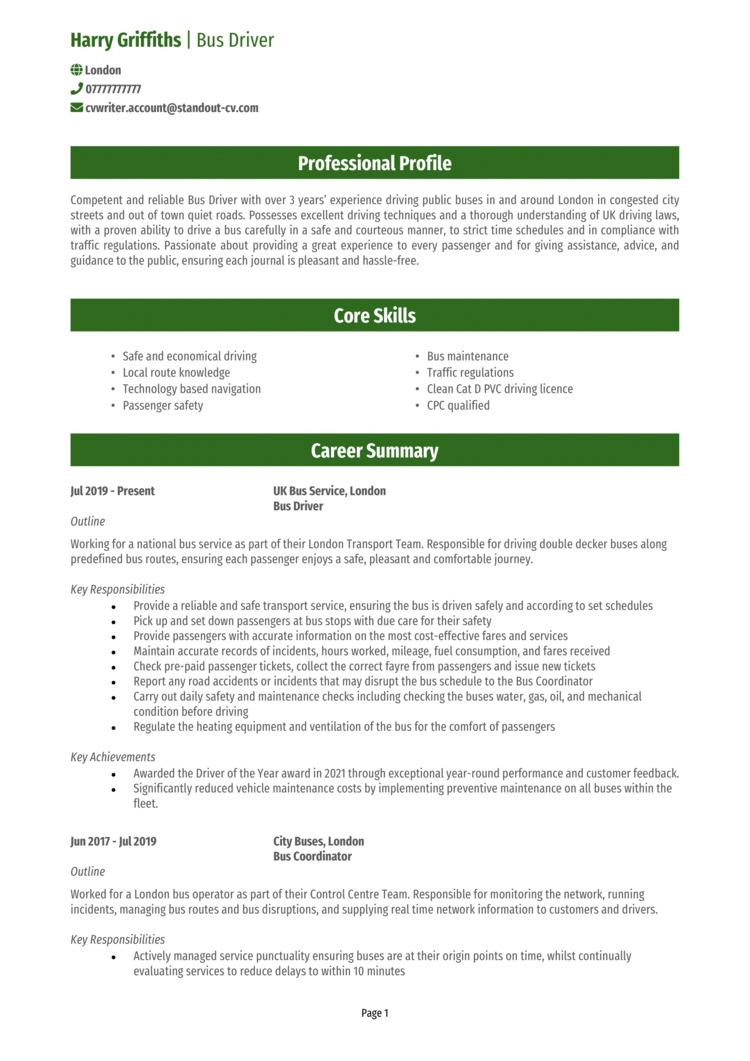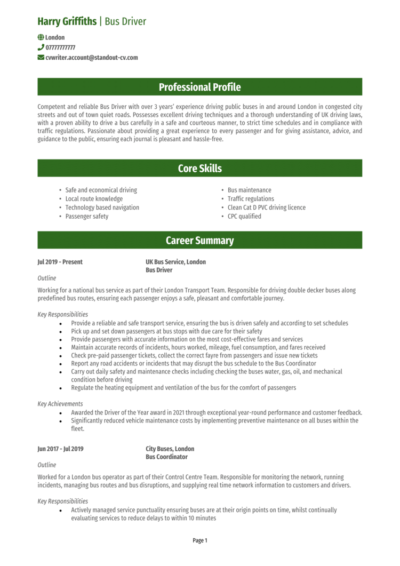You’ve got the focus to keep things moving on schedule – but before you hit the road in your next role, your CV needs to steer you in the right direction.
Driving a bus is about more than just following a route – it’s about responsibility and customer care. This guide (with a Bus Driver example CV) will help you put together a clear and professional CV that highlights your service skills and your ability to stay calm under pressure.
Bus Driver CV

How to write your Bus Driver CV
Discover how to craft a winning Bus Driver CV that lands interviews with this simple step-by-step guide.
You don’t need to overtake the competition – you just need a CV that gets you noticed. From public transport operators to private shuttle services, employers want reliable drivers with a steady hand and a strong customer focus.
This guide will show you how to write a CV which highlights your licences and experience, and showcases the traits that make you a great fit for any bus driving role.
How to structure and format your Bus Driver CV


A well-organised CV is just like a well-run route: smooth, direct, and easy to follow. Employers don’t have time to dig through traffic – so keep your CV structure easy to read. This way, your expertise will be immediately obvious, without forcing recruiters to navigate through a messy layout.
Here’s the layout to follow:
- Name and contact details – Display your personal details clearly at the top so employers can get in touch easily. Including a photo is entirely optional.
- Profile – Give a short summary of your experience, licences, and professional attitude.
- Core skills – Bullet point key strengths that match the job.
- Work experience – Start with your most recent role and work backwards, showcasing achievements and responsibilities.
- Education & certifications – Include licences, training courses, and any academic qualifications like a degree.
- Additional info – You can optionally add language skills, awards you’ve earned, professional memberships, or relevant hobbies and interests.
Use a readable font, divide your CV into distinct sections, keep your bullet points clear and to the point, and stick to a maximum length of two pages. Make it easy for employers to quickly find your experience and licences without needing to dig. Clean CV formatting free from errors shows professionalism – and that you understand the importance of clear communication, just like you would on the job.
How to write a Bus Driver CV profile


Your CV profile gives recruiters a snapshot of your driving experience and your suitability for the role. Keep it concise and tailored to the kind of service you want to provide. It’s also your first opportunity to show you understand the responsibility of transporting passengers safely and efficiently – while maintaining a friendly, customer-focused attitude at all times.
Bus Driver CV profile examples
Profile 1
Reliable and safety-conscious Bus Driver with over five years of experience operating public transport services across urban and rural routes. Skilled in vehicle inspection, route adherence, and customer service. Holds a clean PCV licence and CPC certification. Committed to ensuring passenger safety, comfort, and on-time performance while maintaining a professional and courteous approach.
Profile 2
Experienced Bus Driver with four years of driving experience for both private hire and scheduled services. Adept at handling high-traffic routes, assisting passengers with mobility needs, and dealing calmly with unexpected delays or route changes. Strong track record of punctuality, safe driving, and positive passenger feedback.
Profile 3
Responsible and punctual Bus Driver with six years of experience operating city routes and school transport services. Proficient in route navigation, ticketing systems, and handling minor vehicle faults. Known for clear communication, helpful attitude, and consistently maintaining safety and cleanliness standards on board.
Details to put in your Bus Driver CV profile
Here’s what to include:
- Where you’ve worked – Mention the operators, councils, or services you’ve driven for.
- Your top qualifications – Note your PCV licence and any CPC modules completed.
- Essential skills – Emphasise awareness, reliability, and route knowledge.
- Experience with customer-facing roles – Highlight your ability to support passengers and manage on-board issues.
- Safety and punctuality focus – Show your commitment to secure, efficient, and dependable service.
What to include in the core skills section of your CV


This section offers a quick overview of the qualities that make you a safe and trusted driver. You don’t need to list every skill – just the most relevant ones for the role you’re applying for.
Rather than naming generic attributes, use this space to give a sense of your working style: how you manage routes, handle busy shifts, assist passengers, and stay alert on long journeys. These qualities speak volumes about how you’ll perform on the job.
What are the most important skills for a Bus Driver CV?
- Route Navigation and Scheduling – Operating buses on designated routes while adhering to timetables and transport schedules.
- Passenger Safety and Assistance – Ensuring safe boarding and disembarking, assisting elderly or disabled passengers when required.
- Vehicle Operation and Control – Driving safely and efficiently while maintaining full control of the vehicle in all traffic conditions.
- Customer Service – Providing courteous and helpful interactions with passengers, answering questions, and resolving concerns.
- Ticketing and Fare Management – Managing fare collection, issuing tickets, and verifying travel passes.
- Traffic and Safety Regulation Compliance – Following road laws, transport regulations, and internal operating procedures.
- Pre-Trip Inspections – Conducting daily vehicle checks to ensure roadworthiness, including brakes, lights, and fluid levels.
- Incident Reporting – Documenting and reporting delays, accidents, or emergencies in accordance with company policy.
- Crisis and Emergency Handling – Responding calmly to on-road incidents or passenger emergencies, including administering first aid if trained.
- Time Management – Maintaining punctuality and ensuring minimal disruption to the bus service schedule.
How to write a strong work experience section for your CV


This is where you show your time behind the wheel. Whether you’ve worked for local authorities, schools, private firms, or major city transport services, describe what you did and how you kept things moving safely and smoothly.
List your work experience in reverse chronological order. For each, mention the type of service (e.g. local routes, long-distance, school transport), your employer, and key duties. Break down responsibilities using bullet points, and include any achievements like strong safety records or commendations.
Structuring your jobs

- Outline – State the employer and the type of route or service you provided.
- Responsibilities – Use action verbs like “operated,” “assisted,” “maintained,” or “monitored.”
- Achievements – Include results like “maintained a clean driving record,” or “commended for punctuality and passenger service.”
Sample jobs for Bus Drivers
Bus Driver | GreenFleet Transport
Outline
Operated scheduled local bus services for a regional transport company, ensuring safety and punctuality for passengers across daily routes.
Responsibilities
- Performed daily vehicle checks before departure to ensure roadworthiness and compliance.
- Adhered to timetables while maintaining a safe and smooth driving style.
- Assisted passengers with disabilities, prams, and luggage when boarding and exiting.
- Handled fare collection using an electronic ticketing system and provided route information.
- Maintained a clean and orderly vehicle, reporting any faults or incidents to depot control.
Achievements
- Maintained a 100% accident-free record over three years of service.
- Received frequent commendations from passengers for courteous and helpful conduct.
- Consistently met on-time performance targets across all assigned routes.
Bus Driver | MetroWays Public Transport
Outline
Transported passengers on city centre and suburban routes for a major urban bus operator, managing high passenger volumes during peak travel times.
Responsibilities
- Followed scheduled routes while responding to real-time traffic conditions and diversions.
- Interacted with passengers, answering questions about stops, fares, and service changes.
- Completed shift logs and defect reports in line with company policy.
- Monitored safety cameras and ensured all passengers followed safety regulations.
- Liaised with traffic control to report incidents or delays during service.
Achievements
- Praised by supervisors for consistent route knowledge and timekeeping.
- Helped introduce a passenger boarding initiative that reduced dwell times at busy stops.
- Achieved top marks in annual customer service and safety assessments.
Bus Driver | Silverline Coach Hire
Outline
Provided safe and efficient transportation for school runs, private tours, and corporate shuttle services for a private hire coach company.
Responsibilities
- Collected and dropped off passengers at designated times and locations across varied routes.
- Maintained a professional appearance and communicated clearly with clients and school staff.
- Performed minor maintenance checks and ensured vehicle cleanliness before every journey.
- Adhered to strict schedules while adjusting for road closures and event traffic.
- Ensured full compliance with passenger safety rules, including seat belt use and supervision.
Achievements
- Recognised by regular clients for professionalism and punctuality.
- Maintained an exemplary driving record with no penalties or complaints.
- Supported new drivers through route familiarisation and procedural guidance.
How to list your educational history


Driving qualifications are the foundation of your application. List your most recent and relevant certifications first – especially your PCV licence and CPC (Certificate of Professional Competence). Include dates and training providers where possible.
You can also include any secondary school education or first aid certificates, especially if they’re relevant to working with the public or vulnerable groups. Make sure this bit is pretty brief: the focus of your CV should ideally be on your experience.
What are the best qualifications for a Bus Driver CV?
- PCV (Passenger Carrying Vehicle) Licence – Mandatory for all bus drivers in the UK.
- CPC Qualification (Driver Certificate of Professional Competence) – Required for working legally in professional driving roles.
- First Aid Certificate – Particularly useful for roles involving schools or public service.
- Clean UK Driving Licence – Demonstrates reliability and adherence to road safety standards.
- Customer Service or Conflict Resolution Training – Useful for passenger interaction and on-board incidents.





